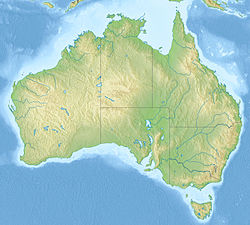The Broome Sandstone, formerly known as the Broome Beds, is an Early Cretaceous geologic formation found in Western Australia, and formerly considered part of Dampier Group. Fossil sauropod tracks, belonging to an unknown ichnotaxon, and stegosaur tracks belonging to the ichnogenus and species Garbina roeorum have been reported from the formation since the 1990s.[2][3][4]
| Broome Sandstone | |
|---|---|
| Stratigraphic range: Valanginian-Barremian ~ | |
 | |
| Type | Geological formation |
| Unit of | Dampier Group |
| Underlies | Melligo Sandstone |
| Overlies | Jarlemai Siltstone (Unconformity), Broome Buchia Beds, Baleine Formation |
| Thickness | 300 m (980 ft) |
| Lithology | |
| Primary | Sandstone |
| Other | Mudstone, siltstone, conglomerate |
| Location | |
| Coordinates | 17°30′S 122°06′E / 17.5°S 122.1°E |
| Approximate paleocoordinates | 50°30′S 86°54′E / 50.5°S 86.9°E |
| Region | Western Australia |
| Country | |
| Extent | Carnarvon Basin Bedout Sub-basin |
See also
editReferences
edit- ^ Thulborn, Tony (2012-05-25). "Impact of Sauropod Dinosaurs on Lagoonal Substrates in the Broome Sandstone (Lower Cretaceous), Western Australia". PLOS ONE. 7 (5): e36208. Bibcode:2012PLoSO...736208T. doi:10.1371/journal.pone.0036208. ISSN 1932-6203. PMC 3360740. PMID 22662116.
- ^ Weishampel, et al. (2004). "Dinosaur distribution." Pp. 517-607.
- ^ "Broome Sandstone". Australian Stratigraphic Units Database. Geoscience Australia and Australian Stratigraphy Commission. Retrieved 25 August 2018.
- ^ Yanijarri-Lurujarri at Fossilworks.org
Bibliography
edit- Weishampel, David B.; Dodson, Peter; Osmólska, Halszka (2004), The Dinosauria, 2nd edition, Berkeley: University of California Press, pp. 1–880, ISBN 0-520-24209-2, retrieved 2019-02-21
Further reading
edit- S. W. Salisbury, A. Romilio, M. C. Herne, R. T. Tucker, and J. P. Nair. 2016. The Dinosaurian Ichnofauna of the Lower Cretaceous (Valanginian–Barremian) Broome Sandstone of the Walmadany Area (James Price Point), Dampier Peninsula, Western Australia. Society of Vertebrate Paleontology Memoir 16. Journal of Vertebrate Paleontology 36(6, suppl.):1-152
